Like everyone else in the rest of the world, I’ve been following the momentous events occurring in Egypt. But reading all the articles, editorials, analyses, and blog posts is a lot of work. Fortunately, there are editorial cartoons, an ancient medium dedicated to providing news to the illiterate and the very lazy.
Editorial cartoons lack the space for any nuanced commentary, so instead they impart a simple message that elicits an immediate emotional response from the reader. Of course, that response can vary depending upon the biases and assumptions of both the artist and the audience. After reviewing all the cartoons I could find addressing the Egyptian protests [primarily from the United States], I noticed that most of them were designed to elicit one of four reactions: joy, fear, ambivalence, or self-criticism.
Joy
Simply put, the overthrow of a dictator is a time for joy.
By Arend van Dam
The people literally become hands that drag down the flail of oppression. Though its not the best idea to bring down the flail on top of yourself.
.
By Daryl Cagle.
.
By Gado
Several artists note that the Tunisian Revolution inspired the Egyptian protests, and the unrest could potentially spread to the rest of the Middle East. In the above panel the movement that began in Tunisia is going to wash away all the dictatorships of North Africa (the one on the left is Mauritania).
.
By John Sherffius
Editorial cartoonists must love countries with recognizable monuments. Here, John Sherffius merges the iconography of Egypt and America, the implication being that Egypt is becoming a nation of liberty.
.
By Steve Benson
Mubarak as a corpse in a sarcophagus. The symbolism presumably being that Mubarak is now buried with Egypt’s past. Or is the unstoppable Mubarak Mummy rising from the grave to reek havoc on the living?
.
By Tony Auth
There was bound to be at least one “Walk Like an Egyptian” cartoon somewhere. No wonder Nadim Damluji was complaining about the “popular trope of Pharaonic culture being used as shorthand for all of Egyptian culture.”
But there are artists who acknowledge that Egypt is now an Islamic country. And those artists are afraid.
Fear
The overthrow of a dictator is a time for joy … unless that dictator is “your man.” It’s no secret that the United States supported Hosni Mubarak for decades, seeing him as the preferable alternative to Nasserism or radical Islam. If Mubarak goes, what will take his place?
By Scott Stantis
Stantis makes the point as plainly as possible. 2011 Egypt = 1979 Iran. If one was so inclined, you could also point out that anti-Americanism is a predictable consequence of propping up brutal dictators, such Mubarak or the former Shah. But it’s far easier just to fret about radical Islam.
.
By Monte Wolverton
Like all editorial cartoonists, Wolverton labels everything just in case his readers are too stupid to get the subtlety of a giant mullah arising from below a pyramid.
.
By Clay Jones
Irony! There is a valid concern that democracy will be used for tyrannical ends, though it’s telling that so many American cartoonists assume that Egypt will become another Iran. .
By Bob Gorrell
The world outside America is a scary place, filled with devils and whatnot. Bob Gorrell’s response is to side with the devils that wear ties.
Ambivalence
On the one hand, you want to celebrate freedom, but on the other hand, you’re afraid of Middle East instability. Don’t worry, you’re not alone!
By Lisa Benson
Given that he’s a Kenyan-Socialist, Obama will likely sit on the left.
.
By Tom Toles
There were countless Mubarak-as-Sphinx cartoons.
.
By Signe Wilkinson
This is why you shouldn’t accept friend requests from dictators in the first place. Also, I kinda hate Facebook analogies.
Self-Criticism
A few cartoonists have a noted the absurdity of promoting democracy while also supporting the strongmen that crush it.
By Jimmy Margulies
A sharp criticism of U.S. policy, though Mubarak probably doesn’t consider himself a U.S. puppet.
.
By Jim Moran
.
By Nate Beeler
These two cartoons make similar points, but Beeler can’t resist the temptation to use Pharoanic imagery.
.
By Pat Oliphant
Oliphant criticizes President Obama’s relatively muted response to the events in Egypt. The obvious counterargument is that Obama is just being prudent, given that Mubarak might still hold on to power and American diplomats would have to continue dealing with his regime.
________________
Most of these cartoons can be viewed at Slate Magazine or Go Comics.

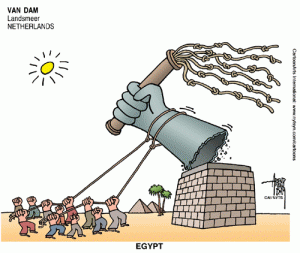
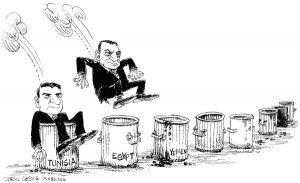
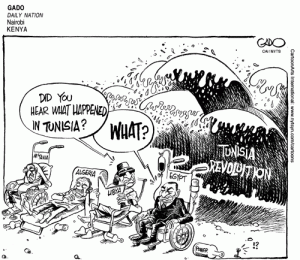
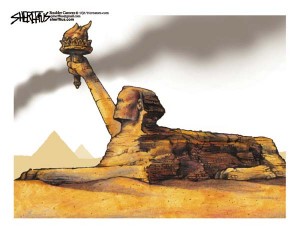


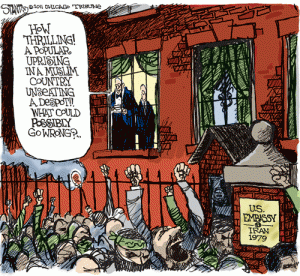
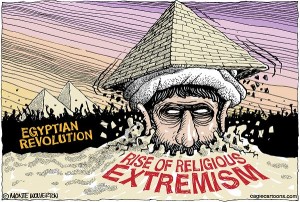
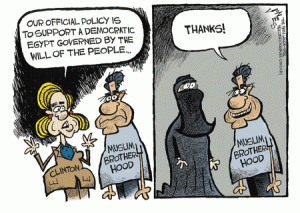
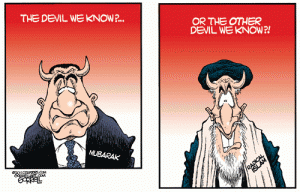
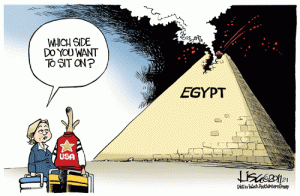
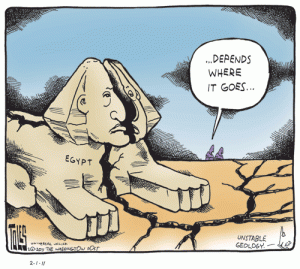
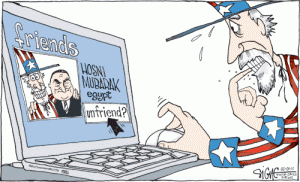
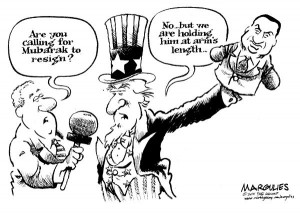
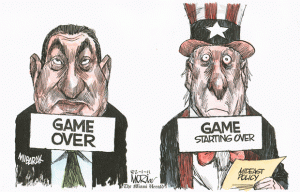
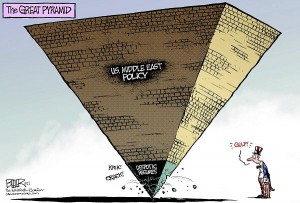

Thanks for this collection. I’m not totally sure about the situation on the ground in Egypt, but I get annoyed at the knee-jerk “Tunisia revolution fuck yeah! Power to the people!” versus “Oh no no but not Egypt, we (USians) need our strategic regional ally” difference in reaction.
Well, I don’t know about you but “Tunisia revolution fuck yeah!” is going to be my new battle-cry.
And that’s a good point about the democracy double-standard. Egypt is unlucky enough to be one of those countries that Americans pay attention to.
I’m with Toles on this, as on so many things.
Hey, the Oliphant cartoon makes sense and his Egyptians don’t look too racist.
“The world outside America is a scary place, filled with devils and whatnot. Bob Gorrell’s response is to side with the devils that wear ties.”
Bob Gorrell has been running our foreign policy for 60 years or so.
Oliphant is an offensive ass for all seasons. I Googled his name and found about twenty articles accusing him of racism and/or anti-Semitism.
The sad thing about Bob Gorrell: the cartoon I posted was actually fairly tame in its Islamophobia, by his standards.
Only offensive asses call a person an “offensive ass” based on a Google search.
There used to be a recurring feature on HU called ‘Oliphant watch’ taking his cartoons apart…was it by Tom Crippen?
Editorial cartoons would be the uncontested worst conceivable example of comics/cartooning…if it weren’t for the newspaper’s comics pages.
And also possibly super-hero comics.
Comics: the medium where you never have to bottom-feed alone.
Alex — Yes, that was me.
On the “offensive ass,” question I’d say a Google search can turn up pretty good evidence about an editorial cartoonist. Their work is meant to be quickly sized up. Sorry, Gerry Allen. If it’s any consolation, I’m willing to say that you’re an offensive ass.
As to Noah’s thoughts on editorial cartoons, I always wondered who were the simple-minded commentators who blamed Sarah Palin for the Tucson shooting. The MSNBC lineup and the liberal blogs I read all stayed away from the charge. Then I saw the cartoons that R.C. Harvey surveyed on tcj’s site.
On the other hand, during the runup to the Iraq war a lot of editoial cartoons from podunk newspapers called bullshit on Bush’s war propaganda. Reading them all in one fell swoop at Slate gave me a very misleading idea of the independence of the American news media during that unhappy time.
Noah- you’ve inspired me to seek out the unholy spawn of an editorial cartoon and a superhero comic. Hmm, If I remember correctly DC Comics published a mini about the 2008 election. That sounds perfect.
Tom- Interesting point about the anti-war cartoons. I guess the advantage of being published in a podunk newspaper is that nobody expects you to tow the party line (because nobody has ever heard of you).
And it’s always worth noting that mainstream news can be pretty terrible, with or without cartoons.
Pingback: Tweets that mention Editorial Cartoons: Four Reactions to the Egyptian Protests « The Hooded Utilitarian -- Topsy.com
I’ve been dabbling in political cartooning for some 15-20 years or so, and I’ve learned a few things about the genre. Regardless of the slant — and without a slant they’re worthless — they should be as direct and pithy as possible; in other words, nothing iffy about the point being. And reading others’ works and struggling with my own I realize that no political cartoonist hits a home run every time, not even the very best. The Egyptian hoopla has got me somewhat flummoxed as there is still too many unknowns exploding from day to day, but my efforts so far have leaned toward the point that Uncle Sam is in a dilemma to take sides — the classic psych 101 approach-avoidance conflict. Of the ones you printed I find the best of the lot Tony Auth’s and John Serffius’s. Different points, but bingo — both right on. Wish I’d thought of those!
P.S. And both Tony’s and John’s cartoons (above) are visuals — utilizing no words. I can’t tell you how close to impossible visuals (without a supporting cast of verbiage) are to pull off successfully. Or even unsuccessfully. Double kudos to those two guys.
P.P.S. I apologize for omitting the word “made” in my fist comment (above), after the sentence “nothing iffy about the point being [made].”
Mike- one of the problems with political cartooning is the pressure to take sides – partly born of the 24 hour news cycle. As Tom Crippen noted, someone like Tony Auth is at least honest in his ambivalence and prefers to wait for things to settle (if only our political leaders were that sensible).
And I agree that the best cartoons are the ones which rely on catchy imagery. As I noted in the post, there is something rather infuriating about cartoonists who label everything.
Hmmm I’m just starting out with political cartooning – essentially lampooning ur corrupt local officials here in upstate New York when they behave poorly and with some who are clearly on the take – conflicts of interests with regard to the industrial wind turbines they- the state are proposing to dot the landscape here in the Great lakes region. Pretty much a feeding frenzie by wind developers for federal dollars and relly less about reducing carbon footprint. Glad to have bumped into this forum of political cartooning – hoping to hone in my drawing skills and gear them towards a broader spectrum and international themes. GM